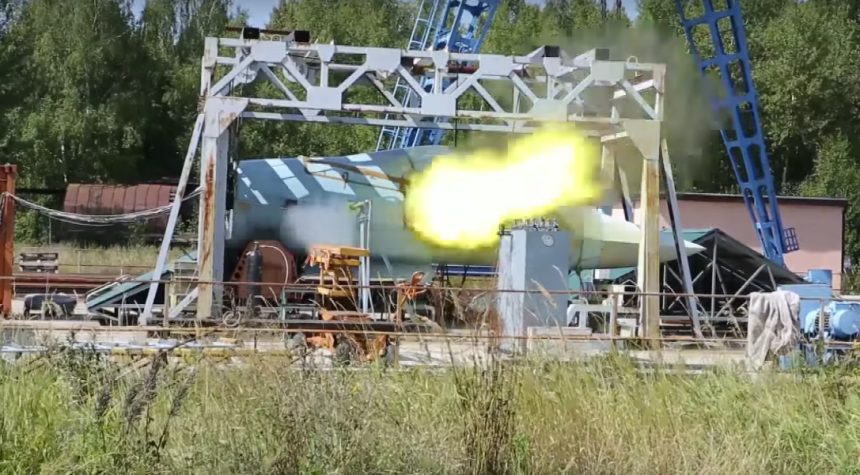A new video showing the tests of the T-50 PAK FA’s 9-A1-4071K cannon has appeared on Youtube.
The Sukhoi T-50 PAK FA, Russia’s 5th generation radar-evading jet, has undertaken live testing of its 30 mm cannon.
Footage reportedly filmed at a range outside Moscow shows a test platform fire the 9-A1-4071K cannon, an upgraded version of the GSh-30-1 30 mm automatic cannon developed by the Instrument Design Bureau for High Precision Weapons in 2014.
Based on the data released so far, the gun (that complements a wide array of weapons that the aircraft will be able to carry), 50 kg in weight, can fire at a rate of 1,800 rounds per minute, “the best such performance for this type of weapon around.”
According to the state-run Sputnik news media outlet “another thing that makes the 9-A1-4071K so special is its autonomous water cooling system where the water inside the barrel jacket vaporizes as it heats up during operation. The 9-A1-4071K cannon can fire blast-fragmentation, incendiary and armor-piercing tracer rounds and is effective against even lightly armored ground, sea and aerial targets. The cannon can hit ground targets up to 1,800 meters away and aerial targets at a maximum distance of 1,200 meters. Flight tests of the 9A1-4071K modernized rapid-aircraft cannon were earlier conducted on the Sukhoi SU-27SM multirole jet fighter.”
The T-50 is a stealth equipped with a front, side and rear AESA radar, as well as L Band radars. It features TVC (Thrust Vectoring Control), a top speed exceeding Mach 2 and a supermaneuverability that makes the stealth plane able to perform, among the others, even the famous Cobra maneuver.
Expected to enter mass production next year, the Russian Defense Ministry plans to buy at least one squadron of T-50 aircraft in 2018.
Theoretically, exports should start in 2020: Sukhoi is working on T-50 variant (that will embed Indian hardware) for the Indian Air Force, even though the latter in 2014 complained in a report that was given wide publicity, that the stealth jet is too expensive, poorly engineered, equipped with inadequate radar.
And, above all, the Indians criticized the unreliable engines.
The Russians have countered that a new, more powerful engine, expected to replace the old AL-41F engine used by the Su-27 family, is under development.
The brand-new motors, along with improved sensors (and more reliable radar – this, as well, planned), will probably make the T-50 a dangerous enemy for both the F-22 and the F-35, preventing embarrassing episodes like those occurred at MAKS 2011.
Back in the 2011, when PAK-FA debuted, both T-50 prototypes had technical problems. The first one, “51” had structural breaks, while second one, “52” suffered a quite embarrassing flameout at the beginning of its MAKS 2011 performance and was forced to abort take off and display.
H/T to @aldana_jp for sending the video over to us.
















